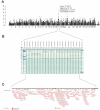Increased expression of MERTK is associated with a unique form of canine retinopathy
- PMID: 25517981
- PMCID: PMC4269413
- DOI: 10.1371/journal.pone.0114552
Increased expression of MERTK is associated with a unique form of canine retinopathy
Abstract
Progressive retinal degenerations are among the most common causes of blindness both in human and in dogs. Canine progressive retinal atrophy (PRA) resembles human retinitis pigmentosa (RP) and is typically characterized by a progressive loss of rod photoreceptors followed by a loss of cone function. The disease gradually progress from the loss of night and day vision to a complete blindness. We have recently described a unique form of retinopathy characterized by the multifocal gray/brown discoloration and thinning of the retina in the Swedish Vallhund (SV) breed. We aimed to identify the genetic cause by performing a genome wide association analysis in a cohort of 18 affected and 10 healthy control dogs using Illumina's canine 22k SNP array. We mapped the disease to canine chromosome 17 (p = 7.7×10(-5)) and found a 6.1 Mb shared homozygous region in the affected dogs. A combined analysis of the GWAS and replication data with additional 60 dogs confirmed the association (p = 4.3×10(-8), OR = 11.2 for homozygosity). A targeted resequencing of the entire associated region in four cases and four controls with opposite risk haplotypes identified several variants in the coding region of functional candidate genes, such as a known retinopathy gene, MERTK. However, none of the identified coding variants followed a compelling case- or breed-specific segregation pattern. The expression analyses of four candidate genes in the region, MERTK, NPHP1, ANAPC1 and KRCC1, revealed specific upregulation of MERTK in the retina of the affected dogs. Collectively, these results indicate that the retinopathy is associated with overexpression of MERTK, however further investigation is needed to discover the regulatory mutation for the better understanding of the disease pathogenesis. Our study establishes a novel gain-of-function model for the MERTK biology and provides a therapy model for retinopathy MERTK inhibitors. Meanwhile, a marker-based genetic counseling can be developed to revise breeding programs.
Conflict of interest statement
Figures


References
-
- Aguirre GD, Baldwin V, Pearce-Kelling S, Ray K, Acland GM (1998) Congenital stationary night blindness in the dog: Common mutation in the RPE65 gene indicates founder effect. Mol Vis 4:23. - PubMed
-
- Hartong DT, Berson EL, Dryja TP (2006) Retinitis pigmentosa. Lancet 368:1795–1809. - PubMed
-
- Pagon RA (1988) Retinitis pigmentosa. Surv Ophthalmol 33:137–177. - PubMed
Publication types
MeSH terms
Substances
Grants and funding
LinkOut - more resources
Full Text Sources
Other Literature Sources
Medical
Research Materials
Miscellaneous

